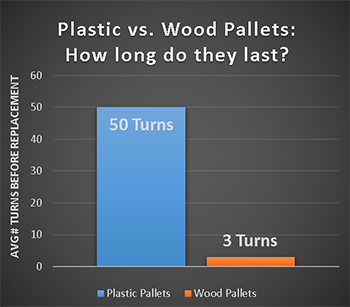Companies that use pallets as part of their supply chain face a choice between plastic vs. wood pallets. Often, price is one of the critical factors in this decision process—and rightly so, as savvy buyers want to keep expenses low.
Which costs less: plastic or wood?
On the surface, wood pallets appear to be less expensive than their plastic counterparts. Because of the difference in this first-cost comparison, companies may believe that they’re saving money by choosing wood for their shipping needs. However, when you dig a little deeper, it becomes clear that first-cost evaluations don’t tell the whole story—you may actually be losing money by choosing the cheaper material.
Let’s take a second look at the plastic vs. wood pallet cost question to see how both options could impact your company’s finances.
The longevity difference

The central consideration here is not just the initial cost of the product, but the utility and longevity you get for your money. Wood pallets are prone to splintering, warping, and fungus or insect infestation, and they are often lost or stolen. Because of these pitfalls, wood pallets often only last 2-3 turns before damage or loss. By contrast, plastic pallets can last up to 50 turns in the right environment before they need replacement, as they are more immune to impact, handling, and environmental hazards (see Fig 1).
Plastic may initially be roughly three times more expensive than wood, but they last at least 10-12 times longer. That yearly savings will flow straight to your bottom line. When plastic pallets do reach the end of their lifespan, they can be returned and recycled for credit toward replacements to replenish your pool.
Because of this stark difference in longevity, it makes sense to use a total-cost evaluation method to compare the costs of plastic vs. wood pallets.
Calculate your total costs
With a total-cost evaluation, you’re not merely comparing the price of 10,000 wood pallets against 10,000 plastic pallets on a first-cost level. Instead, you’re calculating the total cost of ownership over time. The total-cost method accounts for how often you reorder pallets and pay associated operational expenses, which provides a much more precise picture for your overall budget.
As the first step to valuing plastic vs. wood pallets, determine how often you’re currently reordering pallets and how many turns they last on average. Companies that use wood pallets may find themselves reordering every 2-3 turns. Depending on shipping volume, application, and distance, wood pallets could be a recurring operating expense every month or two, or even more frequently.
Next, determine additional associated expenses:
- How much does it cost to order and replace pallets over a year?
- Internally, how much labor time is being spent on evaluating and repairing or disposing of broken pallets? What does this time cost?
- Are you paying extra to ship heavy wooden pallets when plastic would cost less due to its lighter weight?
Finally, based on all these records, add up your total yearly pallet expenses. Once you have this number, you can compare the real value of plastic vs. wood pallets.
Consider this simple illustrative example (see Fig 2): Let’s say you spend $10,000 for 1,000 wood pallets, but you need to replace them every month. In this instance, you’d pay about $120,000 minimum annually. If this were the case for you, it would be significantly better for your bottom line to spend $30,000+ upfront for the same number of plastic pallets that last roughly 10-12 times longer. In this figurative scenario, that one-time expense could carry you through the entire year! When you’re thinking about pallets in terms of even higher volumes, these differences over time will be even more extreme.
Are plastic pallets right for you?
Ultimately, the most successful companies think beyond the short term when evaluating any business expense. When deciding between plastic vs. wood pallets, it often makes sense to spend more upfront for a product that lasts instead of purchasing a cheaper version with a short lifespan.
Depending on your application and business needs, switching from wood to plastic pallets could save you thousands – or even millions – of dollars over the long term. To help determine whether plastic pallets are right for you, contact our sales team online or call 800.356.8150 today